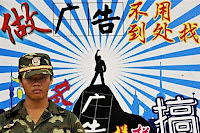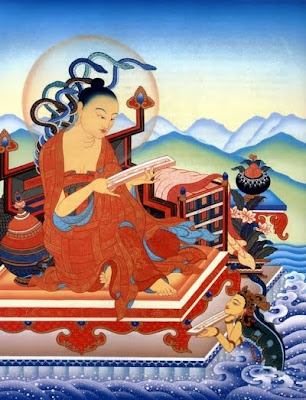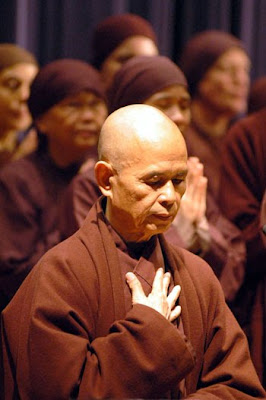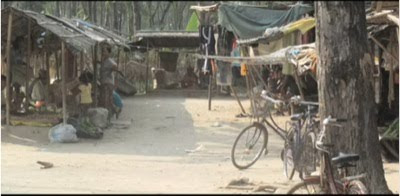 Relive the period at the movie theatre: Mike Myers reliving the 60s in "The Love Guru" (2008); there's also "Across the Universe" and out currently "Taking Woodstock."
Relive the period at the movie theatre: Mike Myers reliving the 60s in "The Love Guru" (2008); there's also "Across the Universe" and out currently "Taking Woodstock."
Monday, August 31, 2009
10 Places to Relive the '60s
US pressures Burma on refugees
Robert J. Saiget (AFP)
 NANSAN, China — The United States on Monday urged Burma to cease attacks on ethnic groups as refugees who fled into China after deadly clashes between junta forces and ethnic rebels nervously headed home. Washington stepped in, piling pressure on, after thousands of people poured into China fleeing fighting in the country's remote north west in recent weeks and Beijing complained of attacks on Chinese-owned businesses.
NANSAN, China — The United States on Monday urged Burma to cease attacks on ethnic groups as refugees who fled into China after deadly clashes between junta forces and ethnic rebels nervously headed home. Washington stepped in, piling pressure on, after thousands of people poured into China fleeing fighting in the country's remote north west in recent weeks and Beijing complained of attacks on Chinese-owned businesses.- PHOTOS: Chinese soldier stands guard at the border separating China and Burma; Chinese guards watch Burmese crossing back into Burma (AFP). Burmese child runs past Chinese paramilitary police preparing to clean refugee camp (AP). More photos
 "We urge the Burmese authorities to cease their military campaign and to develop a genuine dialogue with the ethnic minority groups, as well as with Burma's democratic opposition," US State Department spokesman Ian Kelly said.
"We urge the Burmese authorities to cease their military campaign and to develop a genuine dialogue with the ethnic minority groups, as well as with Burma's democratic opposition," US State Department spokesman Ian Kelly said."The brutal fighting has forced thousands of civilians to flee their homes for safety in Thailand and China, and has reduced both stability and the prospects for national reconciliation in Burma," he said. Washington was working on a "Burma strategy," he added.
Officials in China's southwestern Yunnan province have said 37,000 refugees streamed into their country after days of fighting in Kokang, a mainly ethnic Chinese region of Burma's Shan state. More>>
Nazis; Madonna in Israel; Bush joins "Today"
 VIDEO: DJ AM (Adam Goldstein) died from prescription and recreational drug combo but autopsy inconclusive
VIDEO: DJ AM (Adam Goldstein) died from prescription and recreational drug combo but autopsy inconclusive GAZA CITY, Gaza Strip – A Hamas spiritual leader on Monday called teaching Palestinian children that the Nazis murdered 6 million Jews a "war crime," rejecting a reported U.N. proposal to include the Holocaust in Gaza's school curriculum. [Nazi deal with West started WWII; see below.] More»
GAZA CITY, Gaza Strip – A Hamas spiritual leader on Monday called teaching Palestinian children that the Nazis murdered 6 million Jews a "war crime," rejecting a reported U.N. proposal to include the Holocaust in Gaza's school curriculum. [Nazi deal with West started WWII; see below.] More»  Exiled Tibetan spiritual leader the Dalai Lama, right, kneels and prays for victims and comforts survivors of Typhoon Morakot, at the destroyed village of Shiao Lin, in southern Taiwan, Monday, Aug. 31, 2009 (AP/Wally Santana).
Exiled Tibetan spiritual leader the Dalai Lama, right, kneels and prays for victims and comforts survivors of Typhoon Morakot, at the destroyed village of Shiao Lin, in southern Taiwan, Monday, Aug. 31, 2009 (AP/Wally Santana).
Putin blames WWII on West's deal with Hitler WARSAW, Poland -- Russia's prime minister Vlad Putin [a yakkha on horseback seen on left), condemned Moscow's 1939 treaty with Berlin that carved up Europe, as well as a British and French pact with the Nazis, in remarks published before the 70th anniversary of the start of World War II. More»
WARSAW, Poland -- Russia's prime minister Vlad Putin [a yakkha on horseback seen on left), condemned Moscow's 1939 treaty with Berlin that carved up Europe, as well as a British and French pact with the Nazis, in remarks published before the 70th anniversary of the start of World War II. More»

The White (Caucasian) Huns

- The White Huns (allempires.net)
- New view of history (ranajitpal.com)
The few Hephthalite (Ephthalite) records provide a fragmentary picture of their civilization and empire. Their background is uncertain. They probably stemmed from a combination of the people of the Tarim basin and the Yueh-chih. There is a striking resemblance in the deformed heads of the early Yueh-chih and Hephthalite kings on their coins. According to Procopius's History of the Wars, written in the 6th century, the Hephthalites:
Ephthalites was the name given to them by Byzantine historians, Hayathelaites by the Persian historian Mirkhond, and sometimes Ye-tai or Hua by Chinese historians. They are also known as the White Huns, distinct from the Huns who, led by Attila, invaded the Roman Empire.
They are described as a kindred steppe people who originally occupied the pasture-lands in the Altai mountains of southwestern Mongolia.
Toward the middle of the 5th century, they expanded west probably because of the pressure from the Juan-juan, a powerful nomadic tribe in Mongolia. Within decades, they became a great power in the Oxus basin and the most serious enemy of the Persian empire.
Westward Expansion
When the Hephthalites gained power, Kushan and Gandhara were ruled by the Kidarites, a local dynasty of Hun or Chionites tribe. The Hephthalites entered Kabul and overthrew Kushan. The last Kidarites fled to Gandhara and settled in Peshawar. In about 440 A.C.E. the Hephthalites further took Sogdian (Samarkand) and then Balkh and Bactria.
The Hephthalites moved closer and closer toward Persian territory....The Hephthalites became the superpower of Middle Asia. They not only destroyed part of the Sassanian Empire in Iran but also intervened in their dynastic struggles...
Eastward Expansion into the Tarim Basin
With the stabilization at the western border, the Hephthalites extended their influence to the northwest into the Tarim Basin. From 493 to 556 A.D., they invaded Khotan, Kashgar, Kocho, and Karashahr. The relationship with Juan-juan and China were tightened. The Chinese record indicated that between 507 and 531, the Hephthalites sent thirteen embassies to Northern Wei (439-534) via a king named Ye-dai-yi-li-tuo.
The [Aryan?] Invasion of India
During the 5th century, the Gupta dynasty in India reigned in the Ganges basin and with the Kushan Empire occupied the area along the Indus River. India knew the Hephthalite as Huna by the Sanskrit name. The Hephthalites or Hunas waited until 470, right after the death of the Gupta ruler Skandagupta (455-470), to enter India from the Kabul valley after the conquest of Kushan. They continued along the Ganges and ruined every city and town.
The noble capital, Pataliputra [located by Ranajit Pal], was reduced in population to a village. They persecuted Buddhists and burned all the monasteries. Their conquest was accomplished with extreme ferocity, and the Gupta regime (414-470) was completely extinguished.
For thirty years the northwestern India was ruled by Hephthalite kings. Some of the Hephthalite kings ruling India are found on coins. The most famous ones were Toramana and Mihrakula, ruling India in the first half of the 6th century.
The Language
There are numerous debates about Hephthalite language. Most scholars believe it is Iranian [Aryan] for the Pei Shih states that the language of the Hephthalites differs from those of the Juan-juan (Mongoloid) and of the "various Hu" (Turkic); however, some think the Hephthalites spoke Mongol tongues like the Hsien-pi (3rd century) and the Juan-juan (5th century) and the Avars (6th-9th century).
According to the Buddhist pilgrims Sung Yun and Hui Sheng, who visited them in 520, they had no script, and the Liang shu specifically states that they have no letters but use tally sticks. At the same time there is numismatic and epigraphic evidence to show that a debased form of the Greek alphabet was used by the Hephthalites.
Since the Kushan was conquested by Hephthalites, it is possible they retained many aspects of Kushan culture, including the adoption of the Greek alphabet. More>>
The Glory of Buddhist Gandhara

Gandhara was a cosmopolitan confluence of cultures, East and West (Dawn.com/file).
KARACHI, Pakistan — Ancient Gandhara was a cosmopolitan confluence of cultures where East met West and where, thanks to the network of monasteries, reliquaries (stupas), and temples as well as state patronage, Buddhism experienced a golden age, exemplified by the relics of Gandharan art that survive to this day.
This view was expressed by Mahmood-ul-Hasan Shah, assistant director in the federal government’s directorate-general of archaeology and museums, while delivering a virtual presentation on Gandhara at the Goethe-Institut here on Monday.
The presentation was based on an exhibition titled "Gandhara – The Buddhist heritage of Pakistan: legends, monasteries, and paradise." The exhibition was on display for 10 months in the German cities of Bonn and Berlin. Mr. Shah represented Pakistan during the exhibition in Germany. He initially gave a historical background of the area known in antiquity as Gandhara, consisting of parts of modern Afghanistan and north-western Pakistan.
 Buddhism was patronised by the area’s Kushan rulers – who had originally come from Central Asia – and experienced its golden age from the first to the fifth century AD, when it was "dealt a death blow," as Mr. Shah put it, by the White Huns, who practiced Hinduism [or early Vedic religion].
Buddhism was patronised by the area’s Kushan rulers – who had originally come from Central Asia – and experienced its golden age from the first to the fifth century AD, when it was "dealt a death blow," as Mr. Shah put it, by the White Huns, who practiced Hinduism [or early Vedic religion].He described the people of Gandhara as "totally cosmopolitan," adding that the art that emerged from the area was influenced by indigenous cultures as well as Greco-Roman culture. More>>
- RELATED
Interpreting the Great Recession
The business of idol making
Miss Universe competition
India Art Summit opens, minus most acclaimed painter - MOST READ
CIA should keep an eye on Dr. Khan, says Cheney
The [Indo-Pakistan] guns of August
Informed choices vs morality
World War II: where did combat start?
A true successor to Baba-i-Urdu - MOST EMAILED
Coastal erosion threatens India’s idyllic beaches
Informed choices vs. morality
Kashmiris oppose Pakistan’s Northern Areas package
US admiral’s advice
Billion dollar gift -- lessons learned
Warren Buffett's adult children share what they learned after receiving a giant sum. How Buffett got rich
- Construction worker accused of shooting cop (S.F. Chronicle)
Thousand Buddha Cliffs discovered in China

In early August, three cliffs each containing hundreds of Buddha carvings appeared beside a reservoir in San Su County, in Sichuan province, China. The Buddhas, which have different expressions, are well preserved.
 Most villagers said they never knew these "Buddha cliffs" existed. However, an old man said he had seen them about 49 years ago. In fact, this place used to be a temple. In 1963, construction of the Chen Gou Reservoir was completed, and the three Buddha cliffs were submerged. In 1983, it was declared a heritage conservation unit at the county level.
Most villagers said they never knew these "Buddha cliffs" existed. However, an old man said he had seen them about 49 years ago. In fact, this place used to be a temple. In 1963, construction of the Chen Gou Reservoir was completed, and the three Buddha cliffs were submerged. In 1983, it was declared a heritage conservation unit at the county level.
According to one expert, the decision to submerge the Buddha cliffs in water was opposed by cultural sectors. However, compared to exposing the Buddhas to the elements, submerging is a much a much better preservation method even though they would also be eroded by water to some extent. Source
Buddhism and Quantum Physics
 Nagarjuna
Nagarjuna EAST MEETS WEST
What is reality? The mindsets of the modern world provide and oscillate between four answers:
- The traditional Abrahamic (Jewish, Islamic, and Christian) religions speak about a creator that holds the world together. It represents the fundamental reality. If it were separated from the world for even a moment, the world would disappear immediately. The world can only exist because this creator is maintaining and guarding it. This mindset is so fundamental that even many modern scientists cannot deviate from it. The laws of nature and elementary particles now supersede the role of the creator.
- René Descartes takes into consideration a second mindset, wherein the subject or a subjective model of thought is fundamental. Everything else is only derived from it.
- According to a holistic mindset, the fundamental reality should consist of both subject and object. Everything should be one. Everything should be connected with everything else.
- A very modern mindset neglects reality. It could be called instrumentalism. According to this way of thinking, concepts do not reflect a single reality in any one way. Concepts have nothing to do with reality but only with information.
Buddhism refuses these four concepts of reality. It was therefore confronted with the critical reproach of being nihilistic.
If there is neither a creator, nor laws of nature, nor a permanent object, nor an absolute subject, nor in both, nor none, what is there to believe in? What remains that can be considered a fundamental reality?
The answer is simple. It is so simple that we barely consider it being a philosophical statement: Things depend on other things. A "thing" is dependent on its cause(s). There is no effect without a cause and no cause without an effect. There is, for instance,
- no fire without fuel
- no action without an actor
- no actor without action.
Things are dependent on other things. They are neither identical with each other, nor do they break up into objective and subjective parts. This Buddhist concept of reality [known as Dependent Origination] is often met with disapproval and considered incomprehensible. But there are modern modes of thought with points of contact.
For example, there is a discussion in quantum physics about fundamental reality. What things are fundamental in quantum physics?
- particles
- waves
- field of force
- law of nature
- mindsets
- information
Quantum physics came to express itself by certain key concepts: complementarity, interaction, and entanglement. According to these, there are no independent but only complementary quantum objects. They are at the same time both waves and particles. Quantum objects interact with others, and they show evidence of entanglement even when they are separated by great distances.
Without being observed philosophically, quantum physics has created a physical concept of reality. According to that concept the fundamental reality is an interaction of systems that interacts with other systems and with its own components.
This physical concept of reality does not agree on the four aforementioned approaches. If the fundamental reality consists of dependent systems, then its basics can neither be independent and objective laws of nature nor independent subjective modes of thought. The fundamental reality cannot be a mystic entity nor can it consist of information only.
The concepts of reality in Buddhism surprisingly parallel quantum physics.
- More: ctkohl.googlepages.com
Physics and Buddhism: The space between
The Space Between Two Things
Abstract - Rudyard Kipling, the famous Indian-born British author, wrote in The Jungle Book: "Oh, East is East and West is West, and never the twain shall meet." In this study I show that Kipling was not completely right: There is common ground between Eastern Buddhist philosophy and Western quantum physics. There is, in fact, a surprising parallelism between the philosophical concept of reality articulated by Nagarjuna and the physical concept of reality implied by quantum physics. For neither is there a fundamental core reality. Rather, reality consists of systems of interacting objects. But such concepts of reality cannot be reconciled with the substantial, subjective, holistic, or instrumentalistic concepts of reality that underlie modern modes of thought. More>>
Kashmir rising: Indian troops killed
 (BBC) Hundreds of thousands of troops are based in and around Kashmir, India, which is fighting a cold war with China on one border ("line of control") and a hot war with Pakistan (and Kashmiri insur-gents) on another part of the same border.
(BBC) Hundreds of thousands of troops are based in and around Kashmir, India, which is fighting a cold war with China on one border ("line of control") and a hot war with Pakistan (and Kashmiri insur-gents) on another part of the same border. 
Kashmir is the gateway to Buddhist India (Ladakh) along the border with Tibet in the vicinity of Dharamsala, home of the Dalai Lama and the Tibetan government in exile.

BACKGROUND
CLICKABLE GUIDE
RELATED INTERNET LINKS
Sunday, August 30, 2009
China urges Burma to bridle ethnic groups
Tim Johnston (Washington Post Foreign Service, Aug. 29, 2009)
BANGKOK, Thailand -- A Burmese government crackdown on powerful ethnic militias that have challenged its rule for more than 60 years has driven 10,000 refugees into neighboring China, prompting a rare rebuke from Chinese authorities, the Burmese military dictatorship's key allies.
 (WQ editorial) The father of Burma's dictator, General Than Shwe, is Chinese. China is the junta's principal enabler purchasing timber, minerals, and defending it in the UN. The countries share a border, which leads to illegal trade sideskirting sanctions.
(WQ editorial) The father of Burma's dictator, General Than Shwe, is Chinese. China is the junta's principal enabler purchasing timber, minerals, and defending it in the UN. The countries share a border, which leads to illegal trade sideskirting sanctions.
China has been balancing support for the Burmese government with backing for the armed ethnic groups that occupy much of the Burmese side of the border. The border regions are heavily influenced by China, with many Chinese businesses taking advantage of the trade in gems, timber and jade. More>>
Thich Nhat Han in hospital with pneumonia

Taiwan: no politics for Dalai Lama's visit
 TAIPEI– Taiwanese officials said Sunday they hope the Dalai Lama will stay clear of politics to avoid angering China during his visit to comfort victims of Typhoon Morakot, the island's worst storm in 50 years. Although the Tibetan spiritual leader has traveled to Taiwan before, many fear his arrival late Sunday could hurt the island's improving relations with rival China — the signature issue in the 15-month-old administration of Taiwanese President Ma Ying-jeou. More>>
TAIPEI– Taiwanese officials said Sunday they hope the Dalai Lama will stay clear of politics to avoid angering China during his visit to comfort victims of Typhoon Morakot, the island's worst storm in 50 years. Although the Tibetan spiritual leader has traveled to Taiwan before, many fear his arrival late Sunday could hurt the island's improving relations with rival China — the signature issue in the 15-month-old administration of Taiwanese President Ma Ying-jeou. More>>Saturday, August 29, 2009
Buddhist News of the Day: Mass Ordination

Ordinands chant and reverentially salute on the grounds of the Golden Pagoda on the outskirts of Bangkok during the mass lay-ordination at Dhammakaya Temple, Pathumthani province, central Thailand on Saturday, Aug. 29, 2009. More than 7,000 men from the provinces throughout the country temporarily ordained as Buddhist monks in a ceremony on Saturday. The newly ordained Buddhist monks will practice Buddhist teachings at rural monasteries until the end of Buddhist "lent" (the Rains Retreat known as Vassa), which this year ends on October 4 (AP/Apichart Weerawong)

Russian President Dmitry Medvedev, center, walks with Russian Buddhist monks outside the biggest Russian Buddhist Monastery in the village of Verkhnaya Ivolga, Siberia, Monday, Aug. 24, 2009 (AP/RIA Novosti, Dmitry Astakhov, Presidential Press Service). MORE PHOTOS
To give the teachings of the Buddha is the most precious gift a Buddhist can offer (Otago Daily Times, 8/28/09).
Two sisters who run a suburban nail shop were convicted Wednesday of aggravated battery after a judge found that they threatened their landlord with a $1 novelty lighter shaped like a gun. The sisters claimed they were using it to light candles for a Buddhist prayer ceremony (Chicago Tribune, 8/27/09).
A group of Buddhist monks from Laos strolled the beach at the Salem Willows on Wednesday, Aug. 19, 2009. They were taking a day trip from Wat Lao Mixayaram Temple in Lowell (The Salem Gazette, 8/27/09).
Completion of 2,500 years of the Buddhist era (Buddha Jayanti) fell on Vesak in 1956. To commemorate this unique event, Buddhists all over the world drew up programs to celebrate the occasion in a fitting manner (Daily News, 8/27/09).
A Buddhist nun and Kung fu master in China has towed eight cars using just her plait (BigPond News, 8/26/09).
Hawaii's largest Buddhist denomination will take its anniversary celebration out of the temple and into the community next week (Honolulu Star-Bulletin, 8/29/09).
Japan Prepares for a Change in Election
Polls show that the main opposition Democratic Party is likely to win over 300 of the 480 seats being contested on Sunday, giving it the majority needed to choose the next prime minister (International Herald Tribune, 8/29/09).
TAIPEI, Taiwan - China experts in Taiwan on Saturday downplayed the risks to China-Taiwan relations from the upcoming visit to Taiwan by Tibetan Buddhist leader the Dalai Lama. According to Lin Chung-pin, a China expert at Tamkang University, the four-day... (EARTHtimes.org, 8/29/09).
Museum of Chinese in America gets a new home
In cramped tenement-like quarters in Chinatown, staff at the Museum of Chinese in America had to be careful not to step on any schoolchildren as they taught a class about the role Chinese immigrants played in building the Transcontinental Railroad (AP via Yahoo! News, 8/29/09).
Bush's Shoe-Thrower Freed
The Iraqi journalist who hurled his shoes at former President Bush wins an early release from jail. Court's rationale
Intro. to Buddhism and "Calm Abiding" meditation
Japan votes in election, opposition tipped to win
7 people found slain at Ga. mobile home; 2 injured
Officials ask how they failed to detect L.A. Times
Crime spree leaves one dead, two wounded (S.F.)
Ex-schoolmate, teacher joyful at Jaycee Dugard
Dissecting a Sex Maniac

Jaycee Dugard case suspect blamed 60's drug use
(WQ) There are Five Precepts in Buddhism. When one is broken, it is a slippery slope and not long before the others give way. In ascending order, consuming intoxicants leads to negligence. Thus negligent, one speaks falsely. One engages in sexual misconduct (kāmesu micchācāra). One takes what is not given (in this case kidnapping women). Sex runs all out of control. If a dead body should turn up, it would be no surprise. Celibacy (brahmacariya) is not a reasonable expectation for anyone but monastics and retreatants. But abstaining from "misconduct" regarding sensuality certainly is. WQ frequently defines and discusses it.
"I undertake to abstain from sexual misconduct."
(Kāmesu micchācāra veramaṇī sikkhāpadaṃ samādiyāmi).
(Contra Costa Times) Phillip Craig Garrido tried to convince a jury that his pot and LSD use were to blame for a 1976 rape in Reno, and he told the victim she was at fault because of her good looks, according to news accounts. A retired Reno police detective assigned to the case said Garrido indicated he preferred sex by force after confessing the crimes to him, according to the Associated Press. At trial, he testified that he indulged his fantasies by masturbating in restaurants and restrooms and while reading magazines and watching movies. More>>
- Jaycee Dugard case highlights failure of psychics
- Bad journalism encourages psychic detectives
- Psychic nearly destroys family (LiveScience.com)

Nancy and Phillip Garrido, second from left and far right, in El Dorado County Superior Court in Placerville, Calif., Aug. 28, 2009, to face 29 felony counts in the abduction case of Jaycee Dugard. Appearing with their lawyers Gilbert Maines and Public Defender Susan Gellman, the Garridos entered a plea of not guilty and are being held without bail (Contra Costa Times/Karl Mondon).
Special Section
Multimedia
Forums
Photos
On the web
Suspect Profile: Phillip C. Garrido
Related stories
Tibet Nomads: China intensifies resettlement
Michael Lipin, Washington (VOA, Aug. 28, 2009)
 The Chinese government announced this week that it has moved about 50,000 Tibetan nomads out of a nature reserve in the west of the country as part of a resettlement program that began in 2005. Beijing says the program is meant to protect the ecosystem of the Qinghai-Tibet Plateau. But Tibetan activists accuse the Chinese government of destroying an ancient nomadic culture that treats the environment with respect. More>>
The Chinese government announced this week that it has moved about 50,000 Tibetan nomads out of a nature reserve in the west of the country as part of a resettlement program that began in 2005. Beijing says the program is meant to protect the ecosystem of the Qinghai-Tibet Plateau. But Tibetan activists accuse the Chinese government of destroying an ancient nomadic culture that treats the environment with respect. More>> Nomad village settlement in Darlag County, Golok Prefecture, Qinghai Province, China (VOA/File).
Nomad village settlement in Darlag County, Golok Prefecture, Qinghai Province, China (VOA/File).
Regular Yoga May Improve Eating Habits
"Mindful eating is a skill that augments the usual approaches to weight loss, such as dieting, counting calories, and limiting portion sizes," study leader Alan Kristal, associate head of the Cancer Prevention Program at the Hutchinson Center, said in a news release from the center. "Adding yoga practice to a standard weight-loss program may make it more effective." More>>
The Bhutan Insurgencies


School children (above) in the last "Himalayan Buddhist kingdom" (WFP); Bhutanese refugee camp in Nepal (boiseweekly.com); King Wangchuck of Bhutan passes throne.
 Bhutan's minority population of ethnic Nepalese had mush-roomed to represent one-third of the population, causing then-King Jigme Singye Wangchuck (left, seen crowning his son) to start a "one nation, one people" policy to deport and strip many of their Bhutanese citizenship.
Bhutan's minority population of ethnic Nepalese had mush-roomed to represent one-third of the population, causing then-King Jigme Singye Wangchuck (left, seen crowning his son) to start a "one nation, one people" policy to deport and strip many of their Bhutanese citizenship. "We left because we were scared that they would imprison us, that they would beat us, that I would be raped," said Matimya Moktan, 41, who arrived in Nepal in 1991 and now lives in a small mud stick hut with her three children and husband in one of seven refugee camps in eastern Nepal. More>>
















































































































































































































































